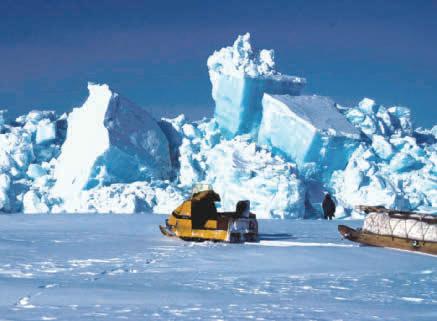
9 minute read
In the News
ON EXHIBIT Resolute—The Spirit of Arctic Exploration
For centuries, the Arctic was the ultimate unexplored frontier. Beginning with ancient quests for ultima Thule, the “farthest unknown,” explorers tried to chart the shifting, icy landscape at the top of the world. Several expeditions set sail during the 19th century in search of the elusive Northwest Passage, some fated never to return. The Resolute Desk given to President Rutherford B. Hayes in 1880 was built from the timbers of just such a ship and is still used in the Oval Office today.
The latest special exhibit at Hayes Presidential Library & Museums in Fremont, Resolute—The Spirit of Arctic Exploration, examines the Arctic’s strange, treacherous environment and profiles the adventurers who tried to tame it.
Final Frontier
“In Hayes’s era, Arctic exploration was the final frontier, and people were fascinated by it in much the same way we are fascinated by the latest images from the James Webb Space Telescope or everything going on with SpaceX,” says Kevin Moore, curator of artifacts.
“As a melting Arctic becomes a key arena for geopolitics and international trade in the 21st century, I hope that visitors will leave with a greater understanding of how this part of our planet was explored, as well as the people who call it home,” he shares. In the exhibit, visitors will discover several attempts to explore the subzero temperatures and icy terrain of the Arctic. The goal was to discover the fabled Northwest Passage over Canada, which would connect the Atlantic and Pacific oceans and create a shorter shipping route.
The Franklin Expedition of 1845 was one of the lost voyages searching for this passage. British Royal Navy officer Sir John Franklin and his group of ships disappeared, and the ships remained missing until finally being found in the 2010s.
While searching for Franklin’s expedition in 1855, the British HMS Resolute became stuck in the Arctic ice, and sailors abandoned it. The following year, the ship finally broke free and floated on its own.
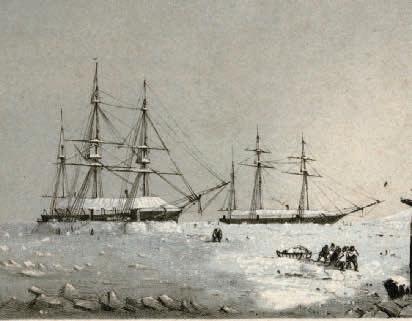
Resolute Desk
An American whaling captain corralled the Resolute , and it was repaired and returned to England. To show the country’s thanks, Queen Victoria had the Resolute Desk created from the ship’s wood for President Hayes. A replica of the Resolute Desk is on display in the Hayes Museum.
The exhibit examines these stories and the harrowing accounts. Navigational tools, some of President Hayes’s books on the Arctic and a model of the Gjøa, the first ship to successfully navigate the Northwest Passage, are on display. In an interactive component, you can map your own Arctic expedition.
Resolute is sponsored by the Randolph J. & Estelle M. Dorn Foundation, with additional funding by Willis & Sons, Inc. Access to the exhibit is included with regular admission to Hayes Presidential Library & Museums. Ohio History Connection members enjoy free admission. The exhibit continues through June 30, 2024.
Hayes Presidential Library & Museums is at the corner of Hayes and Buckland avenues in Fremont. For hours or more information, call 800.998.7737 or visit rbhayes.org.
From Our Director
Necklace of walrus teeth and blue glass beads from President Hayes’s collection, believed to be from an Inuit tribe in the Arctic.
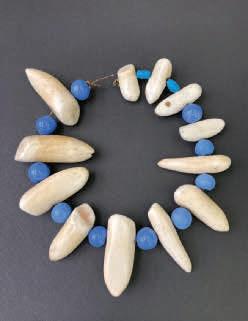
part of my duties as executive director and CEO, I visit communities around Ohio. Whenever I’m in a place, I love to engage with as many local businesses, organizations, museums, parks and eating establishments as possible. A few weeks ago, I was able to complete a multi-day visit to Lima in beautiful Allen County.
As
A little bit about Lima—Lima is in the homelands of the Shawnee, who had to leave the area in 1831 as part of the federal Indian removal policy. It was established as the county seat in 1831, and still serves in that capacity. There was an early oil boom in Lima, and John D. Rockefeller had his first oil well there in 1885. Lima has been home to an Army tank manufacturing plant since 1941.
I started my visit with the team at the Allen County Museum, an amazing place that covers the broad history of the region. An expansive facility, it also includes a log cabin and the Victorian McDonald House. Executive Director Amy Craft Klassen gave me a behind-the-scenes look at its archival collection and its vast railroad collection that rivals any other in the world. Lima was home of the Lima Locomotive Works, and the museum has a Shay locomotive prominently displayed.
I was blown away by the rock and mineral collection with beautiful geodes and mineral specimens. Recently the museum unveiled two incredible works of art—one of 19th-century U.S. Senator Calvin Brice of Ohio, painted by John Singer Sargent, and a painting of Brice’s wife and daughters by Sargent’s teacher, Carolus Duran. The Sargent painting had been in storage and was being conserved when the staff were surprised with the Duran painting from Miami University. The two hang together in a new exhibit.
My trip also included a few great meals—Lulu’s Diner with delicious breakfast, The Met for dinner downtown and a frosted malt at Kewpee Hamburgers. It also included a cold visit to Lincoln Park, where the last locomotive to roll off the line at the Lima Locomotive Works, the 779, is on permanent display—an amazing sight, both for its significance and its sheer size.
Other recommendations: At the Lima Fire Fighters Memorial Museum, you can see photos, newspaper accounts and even the original equipment used to fight some of Lima’s most devastating fires over the last 150 years. At Schoonover Observatory in Schoonover Park, you can look through the 14-inch Celestron telescope, with members of the Lima Astronomical Society on hand to operate it and answer questions. (I always recommend checking on hours before visiting anywhere!)
I had a wonderful time learning about Lima. My thanks to The Lima News, the Allen County commissioners, Visit Greater Lima Convention & Visitors Bureau and all who welcomed me and spent time sharing more about the city and region.
Megan Wood | Executive Director & CEO, Ohio History Connection
HISTORY FUND Twelve Grants
Total $185,624
The Ohio History Connection has awarded 12 Ohio History Fund grants totaling $185,624 to community history and preservation organizations across the state, an amount second only to last year’s total of $207,100.
“The Ohio History Fund allows us to provide tangible support for history and preservation projects all over the state,” says Megan Wood, executive director and CEO of the Ohio History Connection. “These efforts help us understand where we came from and give us a sense of identity and place, reinforcing the importance of every community in our state.”
2023 Ohio History Fund Grant Recipients
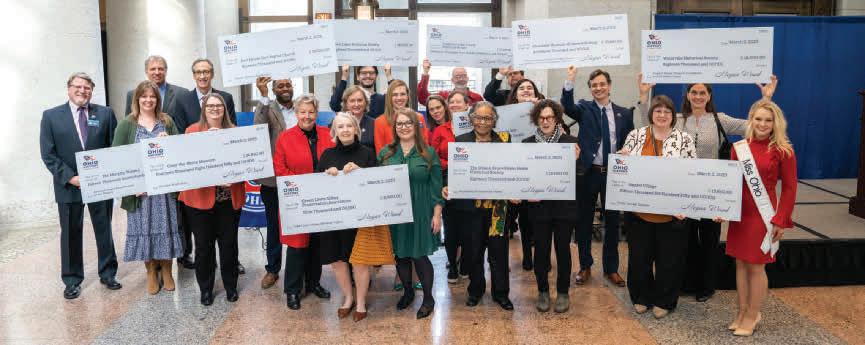
This year’s recipients are:
ARCHBOLD • SAUDER VILLAGE
$15,650 to upgrade textile storage. Sauder Village has a new climatecontrolled and secure storage space for its collection of about 7,000 textiles. The grant will enable it to buy archives-safe storage boxes, shelves and other storage furnishings, and will cover the cost of moving the collection and reinventorying some pieces. The end result will be to keep the collections safer and make objects more accessible for exhibits and programs.
CINCINNATI • OVER-THE-RHINE MUSEUM
$14,850 for window restoration at the museum’s new home, a circa-1870 building at 3 W. McMicken Ave. The museum’s 2022 Historic Site Report indicated that the windows are a priority for restoration, to make the building weathertight as its transformation into a museum begins. The building is listed in the National Register of Historic Places as part of the Overthe-Rhine Historic District.
CLEVELAND • CLEVELAND MUSEUM OF NATURAL HISTORY
$17,000 for preserving an irreplaceable Native American archaeological collection. The grant will help buy museum-quality storage cabinets, shelving and map cases for significant archaeological collections that reveal how Native peoples lived in what became Ohio before European contact.
CLEVELAND • EAST MOUNT ZION BAPTIST CHURCH
$19,000 to aid in stabilizing and repairing the building’s greencolored serpentine stone. Built in 1908 as Euclid Avenue Christian Church, the landmark Romanesque
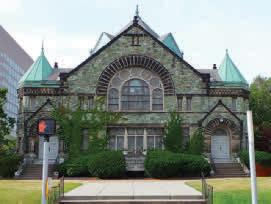
Revival-style building has been the home of East Mount Zion Baptist Church since 1955. It was added to the National Register of Historic Places in 2022 for its local architectural significance and its association with Cleveland’s civil rights history. (See Echoes Magazine, May & June 2022.)
COLUMBUS • GREEN LAWN ABBEY PRESERVATION ASSOCIATION
$9,000 to remove rusted, nonoriginal security grills covering five original stained-glass windows and replace them with new, custommade storm windows to protect the stained glass from weather and vandalism. The project is part of a larger effort to restore and protect 60 stained-glass windows. Built in 1927, the Neoclassicalstyle mausoleum was added to the National Register in 2007.
COLUMBUS • WEXNER CENTER FOR THE ARTS
$18,000 to collect oral histories from curators, artists, staff and others from the Wexner Center’s first decades. The goal is to collect and archive up to 25 interviews and produce videos to share them. The History Fund review panel sees the project as a model for others to follow on a local, state and national level.
LORAIN • LORAIN HISTORICAL SOCIETY
$5,000 for new shelving for textile collections stored in the 1906 Moore House Museum. Overburdened shelves now holding the collections are undermining the floor joists that support them. The grant will aid in buying movable shelving that the structure can better support (thereby preserving the historic house) and pay an intern trained and supervised by the curator to assemble the shelving and rehouse the textiles.
OBERLIN • WILSON BRUCE EVANS HOME HISTORICAL SOCIETY
$18,000 for an accessible restroom for visitors to the 1856 Wilson Bruce Evans Home. A cabinetmaker, Evans was a Black abolitionist and Underground Railroad operative. His house, a National Historic Landmark, is becoming a museum. The society plans to install the restroom in a recent, historically appropriate addition at the rear of the house.
TOLEDO • GREAT LAKES HISTORICAL SOCIETY
$18,000 for a collectionsimprovement project. When the society and its National Museum of the Great Lakes relocated from Vermilion to Toledo in 2014, it lacked the means to move its entire collection of 2,000 artifacts or conclusively determine the scope of its collection. The project resulting from this grant will remedy that, enabling the society to establish firm control over its holdings and be better stewards of the regional history entrusted to it.
WATERVILLE • WATERVILLE HISTORICAL SOCIETY
$18,000 for the Sargent House Museum foundation-and-sill-beam project. Edward Sargent completed his Waterville house between 1839 and 1847. Thanks to the society, the house—one of the community’s early residences—has been preserved and is now a museum. As called for in a structural engineer’s report, the project will repair the original sill beams and dry-laid stone foundation.
WELLINGTON • SOUTHERN LORAIN COUNTY HISTORICAL SOCIETY
$17,419 to continue a project to conserve and exhibit large (11' x 13') Masonic-themed murals that Wellington resident Archibald Willard—best known for the iconic 1876 painting Spirit of ’76 —painted in the 1870s. The grant will let the society hire professional conservators to restore a second mural for display at Wellington’s Spirit of ’76 Museum along with one restored in 2019.
WILMINGTON • MURPHY THEATRE
$15,705 to repair and replicate original decorative plaster moldings in this 1918 theatre’s lobby and auditorium that had been damaged by water leaks, and replace a modern door in the concession area with one that matches an existing historic example. The Murphy is listed in the National Register of Historic Places as part of the Wilmington Commercial Historic District.
About The Ohio History Fund
The Ohio History Fund is a competitive matching grants program funded by Ohio taxpayers’ voluntary contributions through the “check-off” on state income tax forms. In 2006, creation of a tax check-off to fund a statewide grants program for history- and preservation-related projects was identified as a priority by participants in the annual Statehood Day legislative advocacy event sponsored by the Ohio History Connection and nine partner organizations: Heritage Ohio, the Ohio Academy of History, Ohio Archaeological Council, Ohio Council for Social Studies, Ohio Genealogical Society, Ohio Historical Records Advisory Board, Ohio Local History Alliance, Preservation Ohio and the Society of Ohio Archivists.
It became a reality in 2011 when Gov. John R. Kasich signed Ohio’s two-year state budget into law. The tax check-off first appeared on state income tax forms in 2012 for tax year 2011, and the first grants were awarded to 11 recipients across the state in 2012. Since 2013, the Ohio History Fund has made 122 grants totaling more than $1.2 million in 41 counties.
You Help Make Grants Possible
When you make a voluntary gift to the History Fund through the check-off on your Ohio personal income tax form, you help make grants like these possible. The History Fund is also aided by sales of Ohio History “mastodon” license plates and direct contributions to the Ohio History Connection for the Ohio History Fund.
Know of a worthy history- or preservation-related project that could benefit from an Ohio History Fund grant? Applications for 2024 Ohio History Fund grants are due Sept. 12, 2023. Find application forms and more information at ohiohistory.org/historyfund starting in mid-June 2023 or call 800.686.6124 or 614.298.2000
Questions? Contact Ohio History Fund Manager Andy Verhoff at 614.562.4490 or averhoff@ ohiohistory.org









